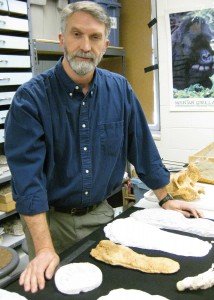
Jeff Meldrum, associate professor of anatomy and anthropology at Idaho State University in Pocatello and author of “Sasquatch:Legend Meets Science“, will be doing a free talk (that’s right, FREE) in Kennewick, Washington.
Meldrum will talk about his extensive research work on the elusive creature. Good news for you Bigfoot enthusiasts in near proximity.
Full source: The News Tribune
1 commentBy John Trumbo
KENNEWICK — When Jeff Meldrum goes into the backcountry, he keeps his eyes, ears and nose alert for signs of Sasquatch.
For 12 years now, the author of Sasquatch: Legend Meets Science has been on the hunt for evidence that will prove or disprove existence of the legendary tall, apelike creature described in hundreds of sightings across much of forested North America.
Meldrum, an associate professor of anatomy and anthropology at Idaho State University in Pocatello, will talk about his research at a free 7 p.m. Thursday program at the Kennewick Library, 1620 S. Union St.
“As a scientist I don’t have the answers yet,” Meldrum said in a phone interview Tuesday. But he hopes his research will be fruitful.
“I’m quite personally convinced there will be a new species of primate confirmed,” he said.
Meldrum said he has more than 200 casts of what may be Sasquatch footprints — each a five-toed impression up to nearly 14 inches long and more than 5 inches wide found at various sites.
Some of those he collected himself in 1996 near Walla Walla, where he had gone to talk to a man who had reported finding tracks in the Blue Mountains. His interest in the legendary creature dates back to when he was 11 years old and saw the famous film taken by Roger Patterson near Bluff Creek, Calif., of a purported Bigfoot running away.As an expert in primate and human locomotion, Meldrum looks for detail that shows the mechanics of how a Sasquatch foot differs from a human’s. The Sasquatch footprints show a foot that flexes in the middle, more like an ape than a man, he said.
Meldrum said he’s so far convinced the oversized biped footprints aren’t of a human. But as a scientist he doesn’t want to jump to a conclusion that Sasquatch, or Bigfoot as the infamous creature has been named in California, is real.
The footprints are intriguing, but Meldrum is more interested in hard evidence such as scat or hair that could offer the possibility of obtaining DNA. He said that’s his goal with this summer’s research.
Past monthlong trips into Sasquatch country have not given Meldrum a glimpse of the mythical creature. But he said he has heard “vocalizations,” and once had his campsite visited by a stealthy biped that brushed by the tent and had sufficient dexterity to unclasp and unzip compartments on a backpack before slipping away into the night.
“I’ve had rocks thrown at me and been in a cabin when something tossed firewood onto the roof,” he said.
In each situation, Meldrum had been in the remote areas for weeks at a time and had positioned himself in areas where Sasquatch sightings had been reported.
Meldrum is serious about his research and isn’t put off by critics, even fellow academics. “I’m seen as the lone voice in the wilderness, but there are others who are just as interested,” he said.
Meldrum believes that if Sasquatch is real, then it has to be a relatively solitary creature whose territory probably includes up to 1,000 square miles.
That would put the total North American population of Sasquatch at between 500 to 1,000 creatures, with as few as 50 in all of Northern California.
Some of the most convincing evidence for Sasquatch to be real is the history of sightings going back hundreds of years, he said.
Meldrum said Native Americans had Sasquatch stories, and so did early Europeans who came to the continent and reported seeing hair-covered wildmen.
Canadian trapper David Thompson, who worked for the Hudson’s Bay Co. and explored the Columbia River from its source to mouth in the late 1790s, also mentioned the strange creature in his accounts of coursing across the Pacific Northwest, Meldrum said.
Thursday’s program will include about an hour of presentation followed by a question and answer period.




